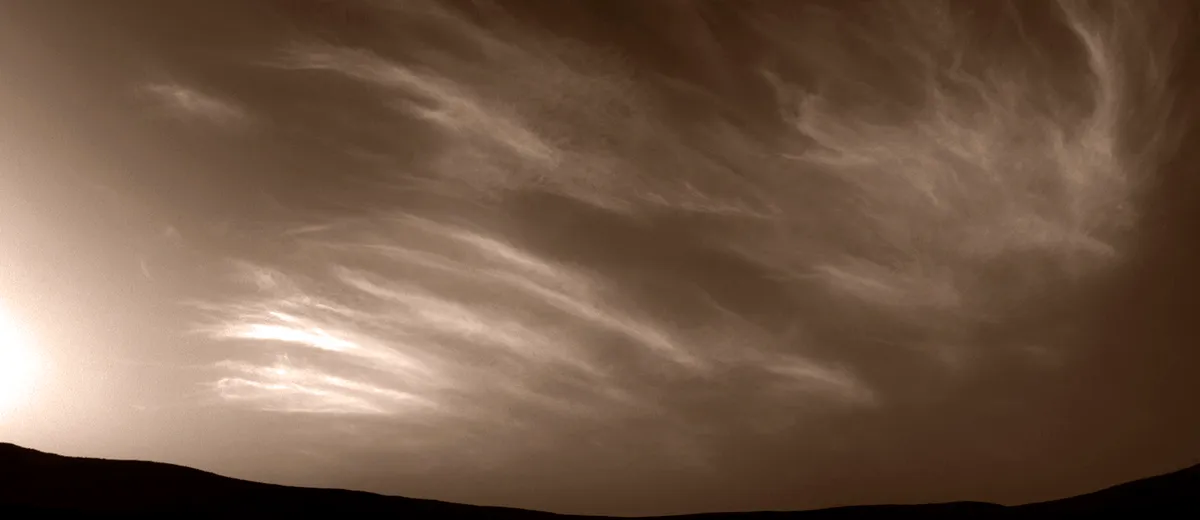Rare and beautiful twilight clouds have been seen on Mars by NASA's Curiosity rover, and the sighting is adding to a real Martian mystery.
Noctilucent – or 'night-shining' clouds are seen on Earth during the summer months, but Curiosity has spotted them on Mars.
The images were captured using Curiosity's Mastcam instrument over a period of 16 minutes on 17 January 2025.
On Earth, you can see noctilucent clouds just as the Sun has set below the horizon, as sunlight shines upwards and illuminates clouds of icy dust on the edge of space.
Curiosity rover captured these images of colourful red and green clouds in the Martian sky, showing that the phenomenon occurs on Mars too.
The variation in cloud colour is caused by scattering light from the setting Sun.
But planetary scientists are left wondering why they only seem to occur in one location on the Red Planet.

How noctilucent clouds form on Mars
Noctilucent clouds on Mars are – just like on Earth – too faint to be seen in daylight, and only visible when the clouds are high and evening has fallen.
Clouds on Mars are made of water ice and, at higher altitudes and lower temperatures, carbon dioxide ice.
In fact, Mars's atmosphere is over 95% carbon dioxide, NASA says.
These higher carbon dioxide clouds are the only ones that seem to produce such colourful iridescence on the Red Planet.

They can be seen near the top of the Curiosity images at an altitude of 37 to 50 miles (60 to 80km).
At the bottom of the images we can also see water-ice clouds traveling in the opposite direction, about 31 miles (50 kilometres) above the rover.
These clouds were seen for the first time on on Mars by NASA’s Pathfinder mission in 1997.
Curiosity first saw them in 2019, and this 2025 occurrence is the fourth time the rover has observed them.
"I’ll always remember the first time I saw those iridescent clouds and was sure at first it was some colour artefact," says Mark Lemmon, atmospheric scientist with the Space Science Institute in Boulder, Colorado.
"Now it’s become so predictable that we can plan our shots in advance; the clouds show up at exactly the same time of year."

Clouded in mystery
Planetary scientists know what causes noctilucent clouds on Mars, and are able to observe them regularly via images captured by Mars rovers, so why haven't these twilight clouds of carbon dioxide ice been seen in other locations on the planet?
Curiosity is located on Mount Sharp in Gale Crater, south of the Martian equator, while Pathfinder operated north of the equator.
NASA’s Perseverance rover, which operates in the northern hemisphere’s Jezero Crater, hasn’t seen any carbon dioxide ice twilight clouds since its 2021 landing.

So what's causing the clouds to apparently only appear in certain locations on Mars?
Planetary scientists think the reason could be gravity waves (not gravitational waves, which are a different thing entirely!)
"Carbon dioxide was not expected to be condensing into ice here, so something is cooling it to the point that it could happen," says Lemmon.
"But Martian gravity waves are not fully understood and we’re not entirely sure what is causing twilight clouds to form in one place but not another."

Curiosity capturing the clouds
The images of noctilucent clouds captured by Curiosity are seen framed in a circular view.
This is because they were captured using one of the Mastcam instrument’s two colour cameras: the left 34mm focal length camera, which has a stuck filter wheel.
Despite the limitations caused by this, scientists at NASA's Jet Propulsion Laboratory are still able to make use of the camera, combining it with the higher-resolution right camera to capture images in colour.
Read the paper led by Mark Lemmon on Martian noctilucent clouds.
Have you ever seen noctilucent clouds on Earth? How do they compare to the ones seen on Mars? Let us know by emailing contactus@skyatnightmagazine.com.
